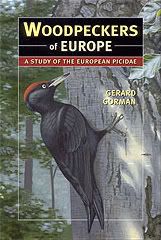Subscribe to:
Post Comments (Atom)
skip to main |
skip to sidebar
Woodpeckers of Europe...
is dedicated to the 10 species of woodpecker (Picidae) that breed in Europe: 9 resident species and the migratory Wryneck. 8 of these 10 also occur outside Europe, with the distribution of Eurasian Three-toed, White-backed, Lesser Spotted, Great Spotted, Black & Grey-headed Woodpeckers stretching eastwards from the Western Palearctic into Asia, whilst Syrian is found in the Middle East & Asia Minor & Wryneck winters in Africa. The global ranges of Green & Middle Spotted Woodpeckers are confined to the Western Palearctic.
I welcome comments, suggestions, photographs, video clips and will credit items used. My aim is to create a non-commercial source for all lovers of the European Picidae. Sincere thanks are due to ALL who have contributed their photos and clips to this blog.
I welcome comments, suggestions, photographs, video clips and will credit items used. My aim is to create a non-commercial source for all lovers of the European Picidae. Sincere thanks are due to ALL who have contributed their photos and clips to this blog.
PLEASE ACKNOWLEDGE & REFERENCE INFORMATION TAKEN FROM THIS SITE !
Gerard Gorman: gerard@probirder.com
The Black Woodpecker - a monograph on Dryocopus martius
Woodpeckers of Europe - A Study of the European Picidae
Woodpeckers of the World
Also look at the Woodpeckers of the World blog
LINKS..
- Bill Baston's Photos
- Birding Eastern Europe
- Birding Hungary
- Campephilus Woodpeckers
- Daniel Bastaja's Photos
- Daniel Petrescu's Photos
- Fero Bednar's Photos
- Gábor Vasuta's Photos
- Göran Ekström's Photos
- Jari Peltomäki's Photos and Tours
- László Nehézy's Photos
- Mladvas Wildlife Photos
- Peter Csonka's Photos
- Picid Pics
- Probirder
- Probirder Blog
- Szabolcs Kókay's Art
- Thomas Kraft's Photos
- Tracks & Signs
- Travelling Birder
- Wildlife & Birding Destinations
- Woodpeckers of the World






1 comment:
Could I have seen a rare Woodpecker? Though it’s none of those you list. The bird looked to me more like a Jay, but not any species I can find.
Just after 2 pm, 3rd December. I was driving near Bredon, Worcestershire, when my approach caused a mixed flock to fly up from where they were feeding on a footpath under an oak tree. Among them was a bird that looked like a Jay, but with plumage a little like a cock pheasant. Either that, or I was confusing two or more birds when they took flight.
As I approach again from the original direction (3rd pass) the feeding flock was reforming and the strange bird was flying down from a tree. It barely touched down before my approach scared it off and it flew back into a tree.
I positioned my car a few tens of yards away and waited. Alas, the traffic was building up and the mixed flock barely had a chance to reform. Over the next 20 minutes I watched the bird mainly from a distance (the longest break in the traffic being no more than 30 seconds), seeing it waiting in the branches of trees, in flight, and only feeding on the ground for about 30 seconds with its tail in the air towards me.
Those plumage colours of which I am certain were: red, black, pale cream / off white. My initial impression was of golden brown on the upper surfaces from neck downwards, and perhaps white bars on the wings in flight (if that wasn’t a pigeon). I also think it had some metallic blue or green.
This bird viciously attacked the ground, throwing up stuff into the air; which was maybe the reason why the mixed flock contained a Robin, Dunnocks, Wood Pigeons, and sometimes a Cock Pheasant.
This strange bird had a black beak like a Jay, if slightly longer. It was the size of a Jay or very slightly bigger. Around the vent and a little forward it was clearly pale cream / off white. Its long tail was black or largely so; the tail was certainly black beneath.
My first impression was that the head was red – bright red – and it had a collar around its neck. The collar was white, blue, green, two of those colours; I’m not sure. As I never got a clear view of the upper surfaces again after my initial approach, I have to assume they were brown. Unfortunately when it was feeding I could only see part of the head briefly when it raised its big black beak, though the head was definitely largely red.
I can eliminate an escaped Parrot, despite the bright plumage, and it wasn’t any Woodpecker native to Great Britain, especially not with such a heavy beak.
I returned later to examine the ground, but could find no signs of disturbance. When this bird perched in the trees it just stayed on a branch waiting for an opportunity to come back down.
The head, tail, and vent plumage ought to be enough to identify it, though it may need someone with an extensive knowledge of birds from around the world. This may interest you, and I’d really like to know what it was.
Post a Comment